The Québec maritime Blog
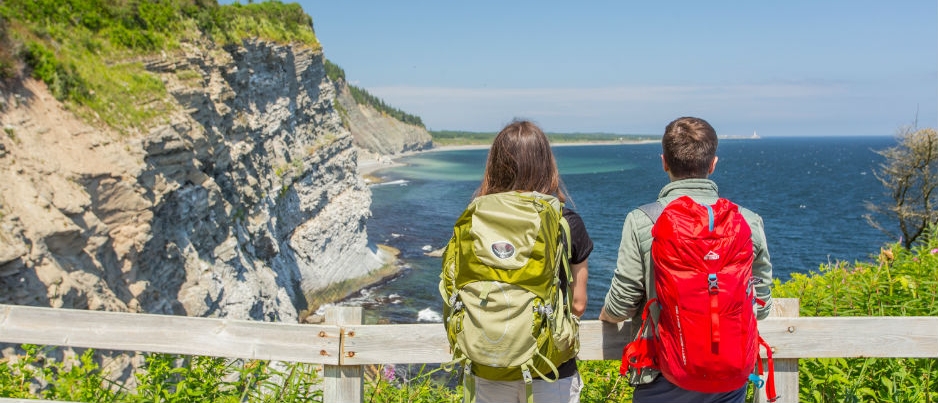
-
Forillon National Park, Gaspésie
Mathieu Dupuis
The Maritime Regions of Québec: A True Paradise for Hikers!
Majestic scenery, rich natural environments and diverse geography are three essential ingredients for great hiking, and all are present in the maritime regions of Québec! Here, then, are some hiking ideas throughout our regions.
On islands
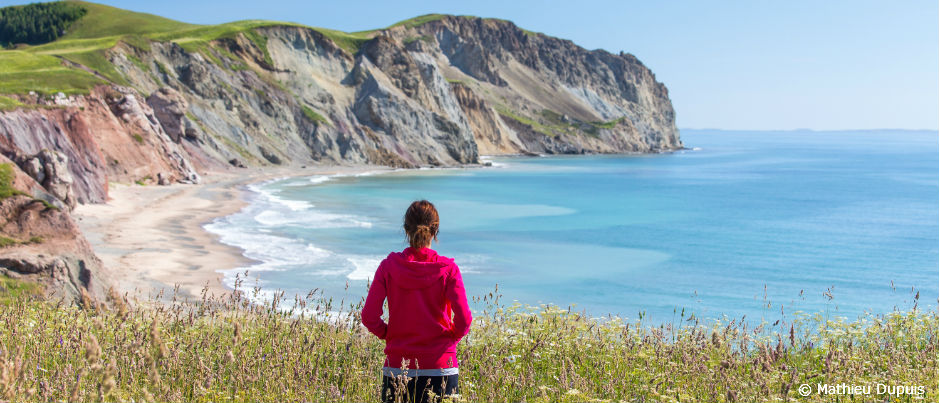
The tranquility inherent to any island environment invites contemplation and relaxation... especially if you’re also on the lookout for whales! On Île aux Lièvres (Hare Island), which is managed by Société Duvetnor in Bas-Saint-Laurent, discover 45 km (30 mi.) of trails as well as natural lookouts and deserted shores teeming with marine life! On the Sept Îles Archipelago in Côte-Nord, enjoy the sea breezes while exploring Grande Basque Island. During your hike, take the time to chat with naturalist guides, who will be happy to share their passion for the rich marine life found in the waters surrounding this island.
Still in Côte-Nord, the Mingan Archipelago National Park Reserve is a true paradise for hikers. Explore the archipelago’s massive monoliths sculpted by the wind and sea, and discover a rich and diverse birdlife. Nine islands of the archipelago offer hiking trails varying in length and level of difficulty.
Located off the Mingan Archipelago, Anticosti Island is also renowned for spectacular scenery. Explore hiking trails that will take you to the island’s main attractions and stroll along beaches that extend as far as the eye can see.
Beaches, bays, coves, lush green hills and cliffs… all of these words describe the unique geography of the Îles de la Madeleine, an archipelago in the middle of the Gulf of St. Lawrence. The Islands boast an extensive network of hiking trails called the Sentiers Entre Vents et Marées, which is nearly 235 km (145 mi.) long and is divided into 13 sections. Climb to the top of Big Hill on Entry Island, which, at 174 metres (571 feet) above sea level, is the highest point in the archipelago. If you have limited time, take advantage of the guided hikes offered by Auberge La Salicorne to make sure you don’t miss anything!
Islands also bear witness to our past. Walk in the footsteps of hermit Toussaint Cartier on Saint-Barnabé Island, off Rimouski in Bas-Saint-Laurent, where you can hike along the shoreline for a total of 12 km (7.5 mi.). Off Percé in Gaspésie, you can also hike across Bonaventure Island or along the shoreline to the northern gannet colony found there. As you do so, admire the island’s heritage buildings, which bear witness to a rich fishing history dating back to the 18th century.
Along the sea
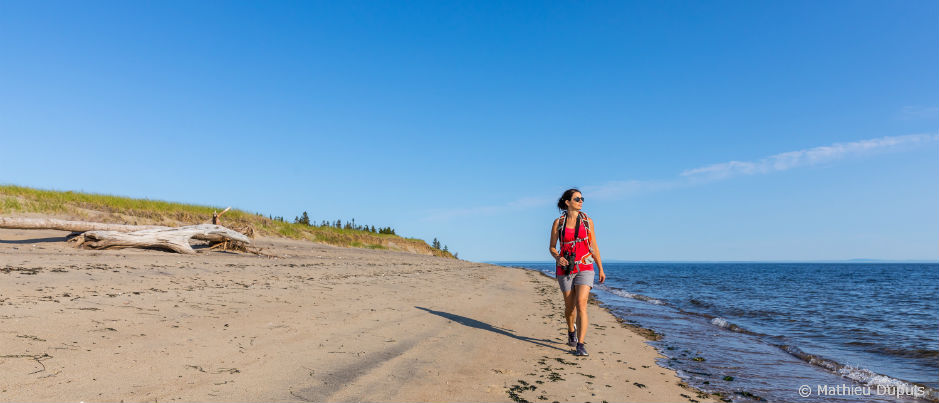
Even on the mainland, the shore is a place where different natural environments meet. This is the case at Parc Nature de Pointe-aux-Outardes in Côte-Nord, which showcases nine different ecosystems. Well-maintained trails will take you through each of them to give you a glimpse of the unique wildlife found in this nature park.
On the region’s western boundary, the steep rock walls of the Saguenay Fjord will amaze you. The trail network at the Ferme 5 Étoiles holiday resort, which links to the trails in Parc national du Fjord-du-Saguenay, will give you access to several breathtaking lookouts over the fjord. Explore these trails during hikes ranging from an hour to several days.
In Gaspésie, Espace NAPAGA offers about 20 km (12 mi.) of trails that will take you along Grand Pabos Bay (a popular bird-watching site) and Lac Chaud as well as to an observation tower.
In Bas-Saint-Laurent, Parc côtier Kiskotuk boasts a network of over 10 km (6 mi.) of trails, some of which offer superb panoramic views of the St. Lawrence. You’ll also have the opportunity to observe several species of birds in this coastal park. Within a few minutes’ drive, at Parc de la Pointe in Rivière-du-Loup, you can walk along the water and admire a magnificent sunset.
In the mountains
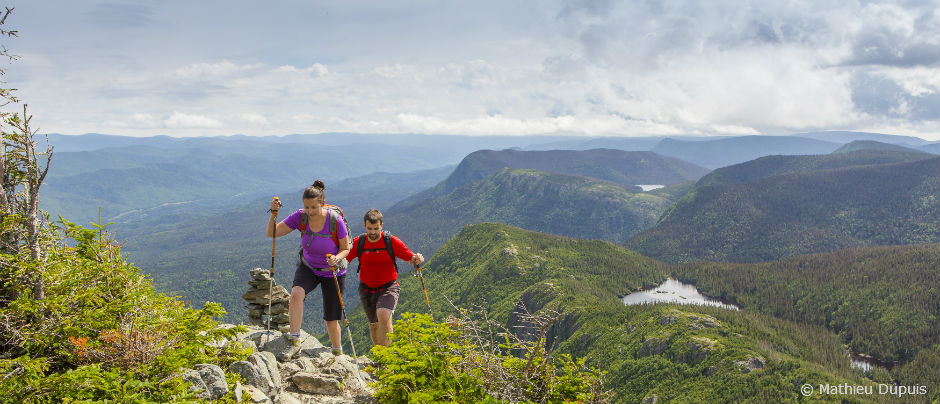
The Appalachian Mountains form the backbone of the south shore of the St. Lawrence. The International Appalachian Trail (IAT) crosses this rugged terrain through deep valleys and dense forests, reaching peaks over 1000 metres (3300 feet) high, which offer stunning 360-degree views of the surrounding scenery. Roughly 650 km (400 mi.) long, this trail is a perfect natural playground for trekking enthusiasts. The trail crosses Parc national de la Gaspésie, a popular hiking destination, then runs along the shoreline from village to village all the way to Forillon National Park. At this point you’ve reached Land’s End, with Cap Gaspé as the grand finale! You can plan your own itinerary or choose from the IAT’s guided packages. Nature Aventure also offers guided packages (including meals), an appealing option if you’re relatively new to trekking.
If you hear the call of the mountains but would rather explore them in a series of day hikes, the Auberge de montagne des Chic-Chocs is the perfect base camp for you. Located right in the heart of the mountains of Gaspésie, this lodge gives you access to about 60 km (40 mi.) of trails, either loops or return trips of a few hours, including sections of the IAT.
In the La Haute-Gaspésie sector, Mont-Saint-Pierre offers two trails you can climb to admire breathtaking views of a glacial valley and the St. Lawrence: the Delta trail (3 km / 2 mi.) and the Lynx trail (15 km / 9 mi.). A shuttle service is also available to take you to the Mont Jacques-Cartier sector of Parc national de la Gaspésie.
In the La Baie-des-Chaleurs sector, Parc régional du Mont-Saint-Joseph offers 35 km (20 mi.) of hiking trails between Carleton-sur-Mer and Maria. If you venture to the top of Mt. Saint-Joseph, which is 555 metres (1820 feet) in altitude, you can enjoy a stunning view of Chaleur Bay.
In Bas-Saint-Laurent, the landscapes in the Kamouraska area are dotted with monadnocks, rocky mounds naturally sculpted over millions of years. At the SEBKA park, you can hike a variety of trails and soak up breathtaking views of the St. Lawrence and the surrounding scenery as you pause at various lookouts along the way.
For the more adventurous, the Uapishka Mountains are the perfect destination. (Uapishka means “always snowy rocky peaks” in the Innu language.) Also known as the Groulx Mountains, this mountain range includes about 30 peaks over 1000 metres (3300 feet) high and is located in the backcountry of Manicouagan, in the region of Côte-Nord. Soak up breathtaking views of the “Eye of Québec,” one of the largest impact craters in the world, and enjoy unmarked hikes through several ecosystems in this territory. Located at the foot of the mountains, the Station Uapishka offers visitors lodging with meals, in addition to providing logistical support for scientific research. Various activities are available on site during which you can appreciate the beautiful surrounding landscapes and the authenticity of the Innu culture.
In the forest
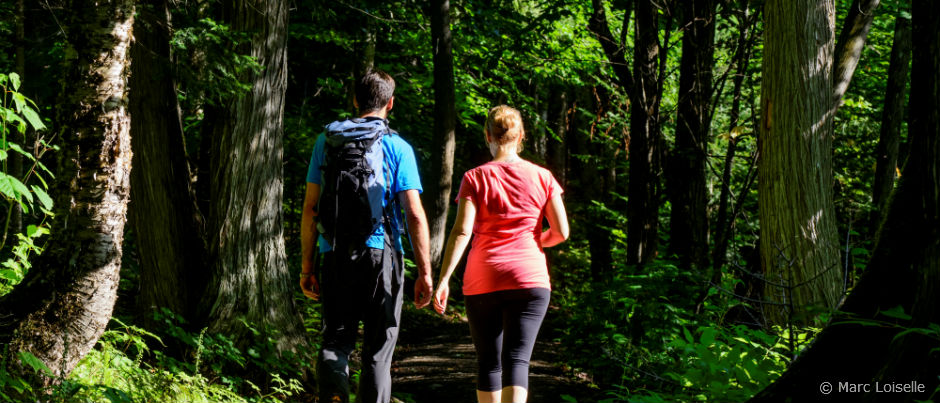
Are you planning a stay in Bas-Saint-Laurent? In Saint-Gabriel-de-Rimouski, go for a walk on the interpretive trails at Domaine Valga, in one of the only old-growth sugar maple and yellow birch stands in Québec. Further west, the Rimouski River runs through a deep canyon at Hell’s Gate Canyon, a site where you can see the impact of the forces of nature in our forests. Trails ranging in length from 1 to 14 km (0.6 mi. to 9 mi.) will take you through the forest and along the river where you can admire the Grand Sault waterfall and cross the canyon on a 63-metre-high (207 feet) suspension footbridge, the highest in Québec!
Thrill seekers will also enjoy visiting the Percé UNESCO Global Geopark in Gaspésie. Dotted with lookouts, the geopark’s challenging trails will take you through a mountainous and forested area. It’s worth the climb for the view from the suspended glass platform: admire the village of Percé, the bay, Percé Rock and Bonaventure Island!
For an enjoyable hike as a family, head to the Lac des Rapides outdoor recreation centre in Sept-Îles, in Côte-Nord. From the lookout on site, you can admire a vast lake and the surrounding natural environment. And why not take advantage of your visit to enjoy some of the many watersports offered here?
In addition to all these options, you can also visit Bic, Lac-Témiscouata and Miguasha national parks as well as wildlife reserves, all of which offer hundreds of kilometres of hiking trails throughout our regions. Make sure to pack your hiking boots!

(0) comment